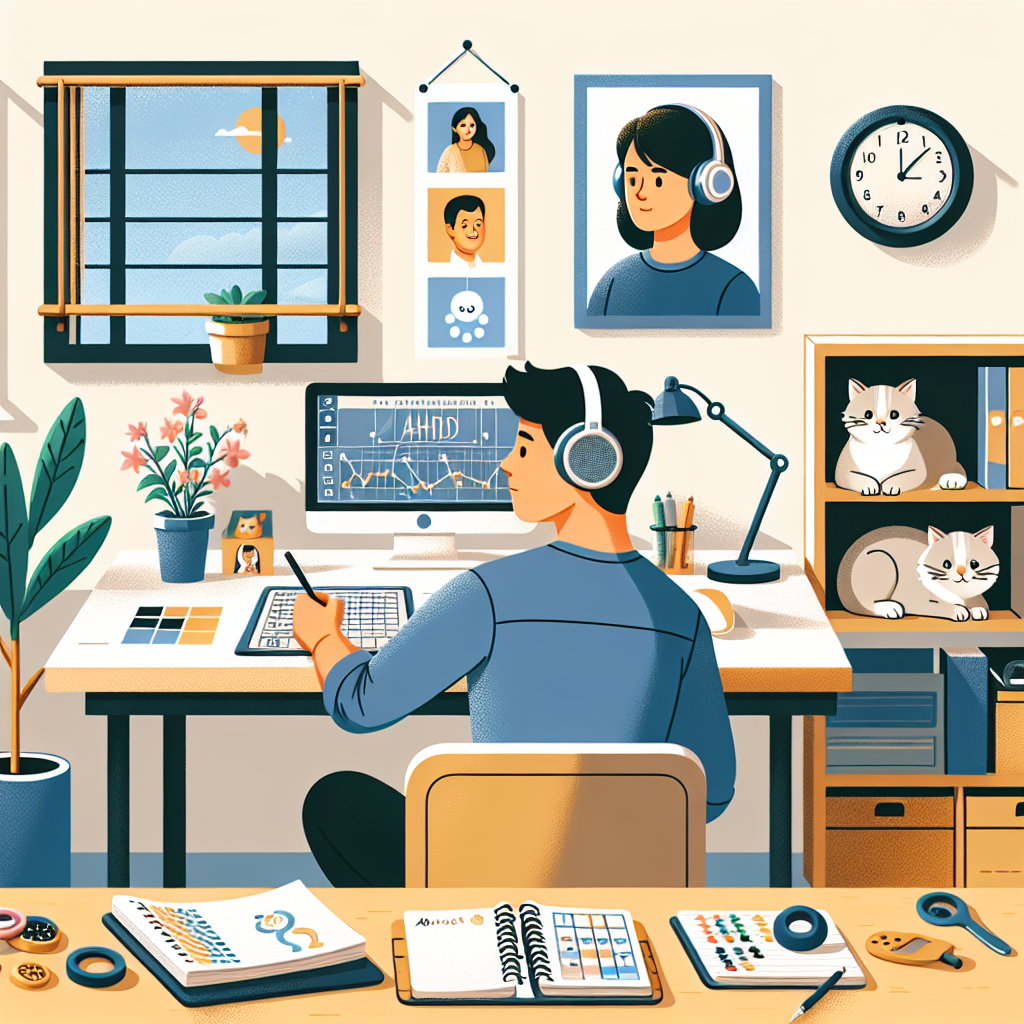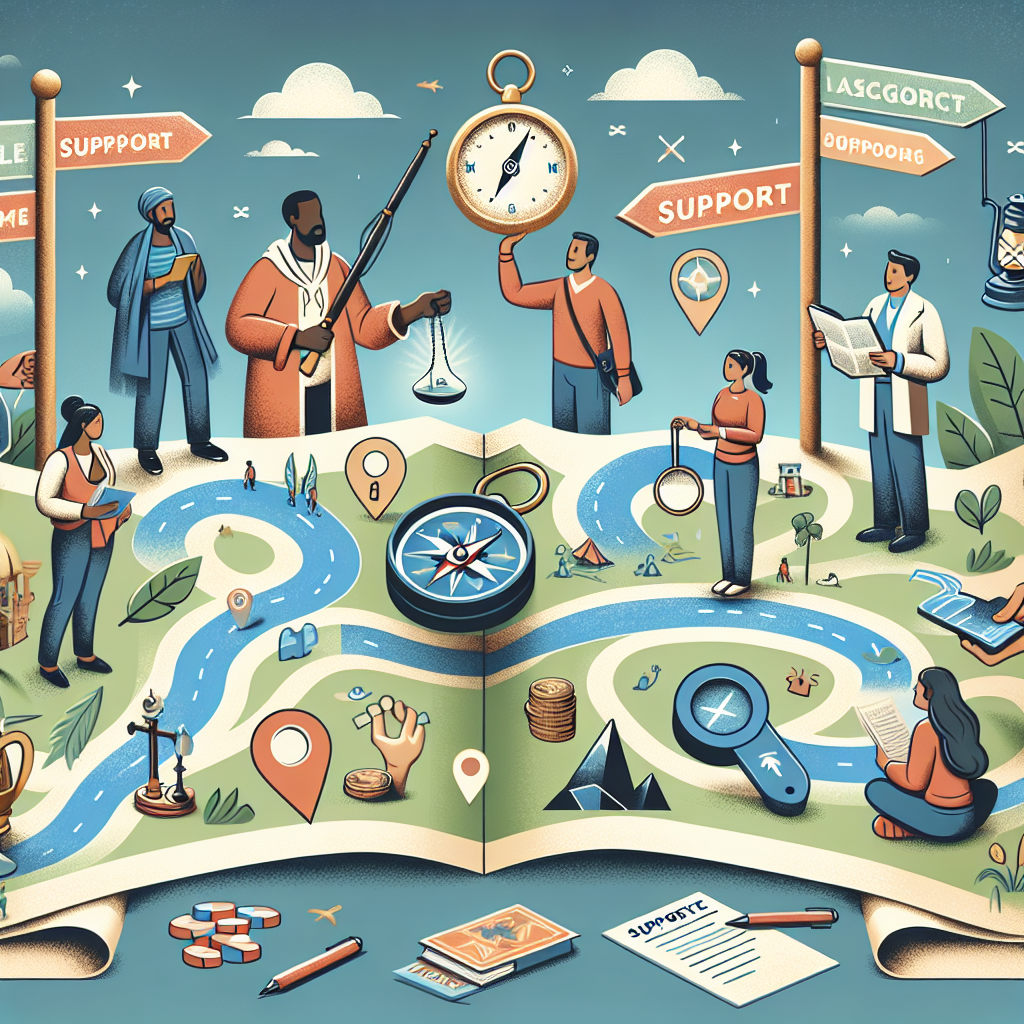
Essential ADHD Management Tools for Success in Work and Life
Living with ADHD as an adult can present unique challenges in both professional and personal settings. However, with the right tools and strategies, managing symptoms and thriving in various aspects of life is entirely possible. This blog post will explore essential ADHD management tools that can aid in achieving success, productivity, and balance.
Understanding ADHD: More Than Just a Diagnosis
So, you’ve just been diagnosed with ADHD, or maybe you’re still figuring out if that’s the case. First things first—ADHD is not a character flaw or a laziness ticket. It’s a neurological condition that affects about 2.5% of U.S. adults, according to the CDC. Now that’s a stat worth a double take!
ADHD often gets pegged as just “hyperactivity,” but it’s so much more. It’s like your brain has 27 browser tabs open and you can’t figure out which one is playing the music! Let’s break down why it’s important to see ADHD as more than just the sum of its symptoms:
The Real Deal: Beyond the Stereotypes
- Complexity is Key: ADHD involves attention issues, impulsivity, and sometimes hyperactivity. The combo varies for each person, making every experience unique.
- Impact on Daily Life: From managing time to juggling emotions, ADHD touches many aspects of life—not just at work but in relationships and personal growth too.
- The Brain’s Wiring: People with ADHD often have different ways of thinking and problem-solving, which can be both challenging and beneficial.
The Emotional Side of ADHD
The emotional rollercoaster ride? Oh yes, it’s real. Managing ADHD symptoms often means navigating emotional highs and lows. This is where mindfulness techniques for ADHD can really help bring some calm into the chaos.
“It feels like I’m trying to mop up water while it keeps raining inside.” – A common sentiment shared in support groups.
If feeling overwhelmed sounds familiar, know there are tons of resources available—from cognitive behavioral therapy (CBT) strategies to online communities—all designed to support those living with ADHD. For more on how therapy can help manage symptoms effectively, check out our article on ADHD/ADD Therapy for Adults.
Embrace the Uniqueness
Having ADHD isn’t all doom and gloom; many folks discover strong creative abilities or exceptional resilience due to their unique wiring. Embrace who you are! After all, being different is what makes us all special.
ADHD Management Strategies: Building Your Toolkit
Life with ADHD doesn’t come with a user manual, but who says we can’t make our own? As adults navigating work, relationships, and the occasional chaotic sock drawer, effective ADHD management strategies can be our secret superpower. Here’s how you can build a toolkit that sets you up for success in both work and life.
Embrace Digital Helpers
In today’s digital age, your smartphone can be more than just a device for doom-scrolling or playing Candy Crush. Transform it into an ADHD productivity powerhouse with apps designed to keep you on track:
- Todoist: A task manager that helps break down projects into manageable tasks.
- Trello: Perfect for visualizing workflows and organizing ideas in boards.
- Forest: Plant virtual trees to stay focused – no saving the rainforest needed!
Cognitive Behavioral Therapy (CBT) as a Game-Changer
If digital tools feel like they need a dose of human touch, cognitive behavioral therapy might be your answer. It helps reframe negative thought patterns and develop coping mechanisms for ADHD. Fun fact: behavioral therapy is often used alongside medication for comprehensive treatment (NIMH). Check out our guide on how CBT can help you succeed at dating in Los Angeles – because who doesn’t need love hacks?
“Behavioral therapy is like having an internal coach reminding you to focus on the goal and not just the squirrels along the way.”
The Power of Routine & Structure
If you’re anything like me, spontaneity is great…until it’s not. Building a routine can be transformative:
- Create Visual Schedules: Use wall calendars or digital planners to visualize your day.
- Set Time Blocks: Allocate specific hours for tasks to avoid the dreaded multitasking trap.
- Meditation Moments: Incorporate short mindfulness breaks to reset and recharge.
Ready to level up your toolkit? Dive deeper into how therapy tools for adults with ADHD can help with emotion control by exploring our insights:
Therapy Insights.
Productivity Tools for Adults with ADHD
Let’s face it: managing adult responsibilities can sometimes feel like trying to herd cats, especially if you’re living with ADHD. But don’t worry, there are productivity tools out there that are designed to help adults with ADHD focus, organize, and get things done—without losing your mind in the process.
1. Todoist: Your Task-Taming Buddy
Todoist is an absolute game-changer when it comes to task management for ADHD. It allows you to create a simple to-do list and breaks tasks into smaller, more manageable chunks. Its color-coded priority levels can help you identify what needs urgent attention, and guess what? You can even integrate it with your calendar for seamless scheduling.
2. Trello: Visual Organization at Its Best
If you’re a visual learner (which many with ADHD are), Trello might just be your new best friend. This kanban-style board helps you visually manage projects and workflows. Plus, moving tasks from ‘To Do’ to ‘Done’ is oh-so-satisfying!
3. Forest: The App That Grows Your Focus
Forest is uniquely delightful. It gamifies staying focused by planting a virtual tree whenever you need to concentrate on a task. If you leave the app before your timer ends, your tree dies—not exactly what we want on our conscience! It’s like having a green-thumbed accountability partner in your pocket.
“ADHD is not about getting rid of distractions; it’s about learning how to handle them.” — Anonymous
4. Evernote: Capture Everything Important
Evernote is perfect if you’re prone to forgetting brilliant ideas that pop into your head at random times (like the middle of the night). It helps collect notes, images, links, and more—all in one place so you never miss a beat.
If these tools intrigue you but you’re struggling with emotional regulation or focus issues that software alone can’t solve, consider exploring ADHD therapy for adults. Therapy could provide additional coping mechanisms to better manage day-to-day challenges alongside these digital aids.
Pro Tip: Experiment! Not all tools work for everyone—find what sticks and make it part of your routine.
Coping Mechanisms for Everyday Challenges
Living with ADHD can sometimes feel like you’ve been handed a Rubik’s cube that someone switched all the stickers on. But fear not, because with the right ADHD management tools, those challenges can be navigated more smoothly. Let’s dive into some coping mechanisms that can help turn those everyday hurdles into manageable speed bumps.
1. Embrace Structure and Routine
Structure is your new best friend. While spontaneity has its charm, for individuals with ADHD, having a routine is essential. Establishing a daily pattern not only sets clear expectations but also helps in managing ADHD symptoms effectively.
- Use Visual Schedules: Incorporate visual schedules to lay out your day clearly. This can include everything from work commitments to social engagements.
- Routine Planners: Daily planners for people with ADHD are designed to break down tasks into small, actionable steps, reducing overwhelm significantly.
2. Mindfulness Techniques
Meditation might sound cliché, but engaging in mindfulness techniques can be a game changer. A study published by the National Center for Complementary and Integrative Health found that mindfulness increases focus and reduces stress levels.
- Start Small: Begin with just five minutes of meditation each day using an app tailored for focus tools for ADHD.
- Breathe Deeply: Simple breathing exercises can ground you during moments of overwhelming distraction or stress.
3. Digital Tools to the Rescue
The digital age isn’t just about memes and cat videos – it’s also about using technology to enhance productivity! Here are some digital allies in your ADHD toolkit:
- ADHD Time Management Apps: These apps help prioritize tasks and send timely reminders so nothing falls through the cracks.
- Cognitive Behavioral Therapy (CBT) Apps: If you’re curious about how CBT can assist in managing symptoms of ADHD, check out our guide on how CBT helps manage schedule changes.
4. Support Groups and Community Resources
No one ever said adulting had to be tackled alone! Engaging with support groups provides an opportunity to share experiences, insights, and solutions unique to managing ADHD as an adult. Platforms such as CHADD, Children and Adults with Attention-Deficit/Hyperactivity Disorder, offer valuable resources and peer support.
“As soon as anyone starts telling you how important it is to be realistic, cross that person off your invitation list.” – John Eliot
The journey of managing life with ADHD may have its ups and downs (and unexpected detours), but remember – you’re not alone on this path! With these coping mechanisms and tools in your arsenal, you’re well-equipped to tackle anything that comes your way.
The Importance of Routine Planners and Visual Schedules
In the whirlwind world of adulting while managing ADHD, a routine planner can be your best ally, saving your day from descending into chaos. Imagine trying to juggle flaming torches while riding a unicycle—sounds daunting, right? That’s how managing daily tasks with ADHD often feels. Routine planners and visual schedules are like that trusty net beneath the high wire; they provide structure and stability.
Studies have shown that implementing structured routines can significantly improve executive function in adults with ADHD. According to ADDitude Magazine, integrating routine planners into daily life helps in reducing anxiety levels by creating predictability.
Why You Need a Routine Planner:
- Structure: Having a set schedule helps streamline your day, making it easier to manage ADHD symptoms.
- Accountability: Keeps you accountable for your tasks, much like having a non-judgmental friend who nudges you when it’s time to get things done.
- Priority Management: Allows you to prioritize tasks effectively, so you know what’s important and what’s not.
Visual schedules are equally powerful tools. Simply put, they’re like GPS for your day—guiding you through the murky waters of competing priorities. They help visualize what needs to be done and allocate appropriate time slots for each task. This method can greatly minimize procrastination tendencies by breaking down daunting tasks into bite-sized, manageable chunks.
The Benefits of Visual Schedules:
- Simplifies Complex Tasks: Breaks down larger goals into smaller, achievable steps.
- Aids Memory Retention: Visual aids reinforce memory through repetitive exposure.
- Cognitive Support: Acts as an external cue for initiating tasks, which is particularly useful for those impacted by forgetfulness or distractibility associated with ADHD.
If you’re still skeptical about embracing routine planners or visual schedules, consider how ADHD therapy for adults can also aid in developing customized strategies tailored to your life and needs. Remember, help is just a planner away!
“The secret of your future is hidden in your daily routine.” — Mike Murdock
Your day doesn’t need to be a scramble to the finish line. By embracing routine planners and visual schedules, you’re setting yourself up not just for success but also for peace of mind that allows you to thrive both at work and home.
Technology: Aiding Focus Through Smart Home Devices
In today’s digital age, technology isn’t just for binge-watching the latest series or ordering takeout with a single click. It can also be a game-changer in managing ADHD symptoms, especially when it comes to enhancing our focus. Enter smart home devices, the unsung heroes of ADHD management tools.
Imagine this: you’re knee-deep in a work project, but your brain keeps reminding you of the laundry. Or perhaps you’re trying to concentrate on that groundbreaking novel you’re writing, but the allure of social media is too strong. This is where smart home devices come to the rescue, acting as both watchdog and facilitator.
How Smart Home Devices Can Help
- Minimize Distractions: Smart speakers like Amazon Echo or Google Nest can play focus-enhancing music or white noise. Just say, “Hey Google, help me concentrate,” and let the calming tunes work their magic.
- Set Routines: Use smart plugs and lights to automate your environment—lights dimming at bedtime or coffee brewing as soon as your alarm goes off. These small routine adjustments can significantly bolster your executive function aids for ADHD.
- Create Reminders and Alerts: With virtual assistants like Alexa, setting reminders for tasks becomes effortless. Whether it’s remembering to drink water or take medication at specified times, these gentle nudges are invaluable.
A study by PubMed Central highlighted that structured routines significantly enhance task performance among those with ADHD. By integrating smart home technology into your daily life, you establish an environment conducive to concentration and productivity—one less reason to lose track of those ever-elusive thoughts!
If you’re intrigued by how more strategic approaches like cognitive behavioral therapy (CBT) can complement these tech tools for comprehensive ADHD management, you might find our article on how ADD therapy for adults can help you get shit done particularly enlightening.
“The secret to getting ahead is getting started.” – Mark Twain
With smart home devices setting the scene and providing support, living alongside an attention deficit diagnosis doesn’t have to feel like a continuous uphill battle anymore. So go ahead—embrace these nifty gadgets and watch as they transform chaos into calm!
The Role of Support Groups in Managing ADHD
Managing ADHD can often feel like juggling flaming swords while riding a unicycle on a tightrope. It’s no wonder that many adults with ADHD seek out support groups to find balance and reclaim control over their lives. But what exactly makes these groups so effective in managing ADHD symptoms? Let’s dive into it.
Why Support Groups Matter
- Community and Understanding: One of the most significant benefits of joining a support group is the sense of community. Knowing you’re not alone in your struggles can be incredibly comforting. When people share similar experiences, it fosters an environment of mutual understanding and empathy that can’t be easily replicated elsewhere.
- Sharing Strategies: Within these groups, members exchange practical ADHD management tools and strategies. Whether it’s the latest ADHD time management app or a simple mindfulness technique for staying present, there’s a treasure trove of advice waiting to be shared.
- Accountability Partners: Let’s face it—sometimes we all need a little push to stick to our goals. Support groups create an environment where members feel accountable to not just themselves, but to each other as well.
The Science Behind It
Research has shown that peer support significantly enhances treatment outcomes for individuals with ADHD. According to a study published in the Journal of Attention Disorders, individuals who participated in peer-led support groups reported improved executive functioning and reduced stress levels compared to those who did not participate (source: [Sage Journals](https://journals.sagepub.com/home/jad)). It’s like having a team of cheerleaders rooting for your success!
“In support groups, friendships are formed that become vital lifelines when navigating the challenges of adulting with ADHD.”
Finding Your Tribe
If you’re considering joining a support group, there are several options available both online and offline. Websites like CHADD (Children and Adults with Attention-Deficit/Hyperactivity Disorder) offer directories for local chapters where you can connect with others facing similar challenges.
Ultimately, the role of support groups in managing ADHD can’t be overstated. They provide not only practical insights but also emotional resilience—a combination that can truly transform how you tackle life’s daily hurdles. So why not take that first step today and see what magic unfolds?
Managing ADHD doesn’t have to be overwhelming or isolating. With a combination of the right tools, strategies, and support network, adults can navigate the complexities of ADHD successfully while leading a balanced work-life existence. By embracing these management tools, achieving personal growth and professional accomplishments becomes more attainable than ever before.


